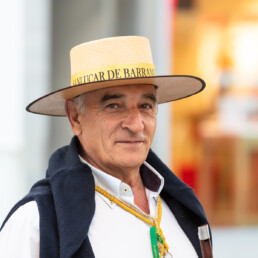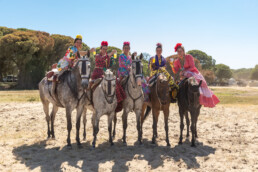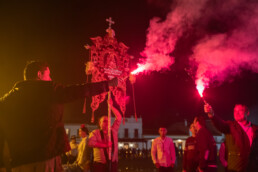Pilgrimage Romería del Rocío
The pilgrimage “Romería de El Rocío” is a procession or pilgrimage on the second day of Pentecost to the Hermitage of El Rocío in the countryside of Almonte, province of Huelva, Andalusia, Spain, in honor of the Virgin of El Rocío.
Morning atmosphere in El Rocío: a light mist lies over the lakes of the “Marismas”, the vast wetlands of the Coto de Doñana Nature Park. Flamingos stand in the water on the opposite bank, looking like a soft pink cloud from a distance… Storks stalk through the meadows in search of food, while bulls and wild horses graze peacefully on the surrounding grasslands. In the middle of the nature park lies the small village of El Rocío, which means “the morning dew”. A sleepy little place where only a few people live and where tourists rarely stray. But once a year, the village awakens from its slumber: over Pentecost, hundreds of thousands of Spaniards make a pilgrimage to El Rocio to pay homage to the village’s legendary Madonna. More than 130 brotherhoods have dedicated themselves to this Marian cult and embark on a very special journey every year. [ Continued below the picture gallery ]
At first glance, El Rocío resembles an abandoned western town – wide sandy paths criss-cross the village, the houses are built with verandas and tethering beams for the horses. For most of the year, most of the houses, restaurants and pubs are closed and the streets are deserted. In the center of the village stands the impressive “Ermita del Rocío”, the dazzling white church with the large entrance portal in the shape of a shell – a true gem of Andalusian architecture. According to an old legend, a shepherd on horseback once found a statue of the Virgin Mary in the hollow trunk of an olive tree. After the municipality of Almonte was spared several misfortunes under the Virgin’s protection, this church was built in her honor as a symbol of faith. For centuries, it has not only been the town’s landmark, but also the destination of one of the largest pilgrimages in Spain.
Reviving traditions
The Romeros, the pilgrims on the traditional route, the “Camino”, come to El Rocío on horseback or mule from all parts of Spain at Pentecost. Sometimes the journey takes up to a week … No effort is too great, no hurdle too high for the journey to the Virgin of El Rocío. Preparations begin weeks in advance: The saddlery is polished, carriages are shined to a high gloss, the horses are re-shod and all the travel paraphernalia is packed. Each of the religious communities carries a richly decorated high-wheeled cart bearing the insignia of the Mother of God. Its silver canopy is crowned by a dove, the symbol of the Blessed Virgin “Blanca Paloma” – “White Dove” in German. During the processions, the pilgrims’ carriages are pulled by magnificent oxen adorned with velvet blankets.
oxen decorated with velvet blankets. The numerous groups of riders and carriages of the brotherhoods are accompanied by colorfully decorated covered wagons and all-terrain vehicles that supply people and animals with provisions on their journey.
The discovery of slowness
For many pilgrims, the motto of this pilgrimage is “the journey is the destination”. They sleep in tents or in the open air along the way and celebrate together around the campfire until the early hours of the morning with the sound of guitars and flamenco. In the morning, people gather in the pine forest to pray: Prayers are said in memory of the Madonna of El Rocío and her blessing is asked for. Despite the arduous circumstances – far away from civilization and modern comforts – people enjoy this journey: Time for yourself, for friends and fellow travelers. Riding alongside each other on horseback at a leisurely pace, having a little chat, toasting with a sherry on the way… The group makes slow progress, but bit by bit they approach the place of pilgrimage. Once they arrive in El Rocío, they move into the houses built especially for this pilgrimage and the horses are stabled in the stables at the back. The richer the brotherhood, the larger and more splendid the house No class distinctions Old and young, rich and poor, from gypsies to landowners come to Rocío. Anyone who is anyone moves on horseback, with the silver medal of the brotherhood of their homeland around their neck and a small glass in a leather case on the saddle – ready to hand so that they can raise a glass of sherry at any time …
Over the course of the days, around 20,000 riders arrive in the small pilgrimage site and gather in front of the cathedral portal to receive the blessing of the priests and pay their respects to the Madonna. The prayers are accompanied by fervent shouts from the crowd and the Virgin is exalted by spontaneous rhythmic hand clapping and flamenco music. Music is played and danced merrily on the verandas of the houses. Proud “caballeros” in traditional Andalusian costume ride from house to house and are invited by the respective landlord for a sherry and served tapas snacks. The women sit stylishly on the horse in flamenco dress – usually behind their caballero, with a small seat cushion on the horse’s croup, their legs crossed at the sides and the hem of their skirt draped elegantly over the horse’s flank. Other ladies can be seen in elegant riding costumes on their own horses, even in side saddles. They like to present themselves to the public – sometimes showing off a piaffe or Spanish walk. At this moment, the viewer realizes that in Andalusia, equestrianism is closely linked to old traditions and customs. A festival without horses and riders is simply unimaginable in the deep south of Spain, the cradle of horse breeding for thousands of years.
A village in a state of emergency
Everywhere you look, groups of riders and carriages pass by, women stroll across the sandy village square of El Rocío in colorful dresses whose flounces cascade down to the ground. And right in the middle of it all, at the center of the action, is the gleaming white church. It is the cocoon that envelops the Madonna. With folded hands and shining faces, devoutly and sometimes with tears in their eyes, the pilgrims gaze up at the female figure enthroned on the altar in a golden robe with a benevolent gaze. Prayers are murmured before her and candles are lit. Outside, meanwhile, people dance enthusiastically. Prayers and celebrations go on for 3 days and 3 nights. There is no contrast here: first into the church for prayers, then on to the pub – typical of El Rocío.
The blessing of the Madonna
On Sunday evening, the faithful gather in the church and on the large sandy square to pray. In a mystical procession, with seemingly endless lines of people carrying thousands of candles and torches in their hands, the pilgrimage reaches its climax. Traditionally at sunrise, usually around 4 a.m., the members of the main brotherhood from Almonte break through the barrier to the church altar at the signal of the priest and carry the statue of the Virgin out into the open amidst the cheers of the crowd. Many of the faithful try to touch the Virgin or at least her robe – the sick and elderly, but also children, are supposed to receive her special blessing in this way. From the cathedral, the “Blanca Paloma” is carried through the whole town to the houses of all the brotherhoods, priests offer prayers of thanksgiving and intercession for the coming year. The prayers continue until the early hours of the morning. From Monday afternoon, the brotherhoods and pilgrims leave again – some of them via their old pilgrimage route – to bring the blessing of Our Lady to their home towns. Peace and quiet returns to El Rocío.
Until next year …

























































































































